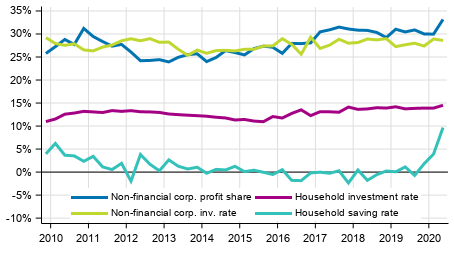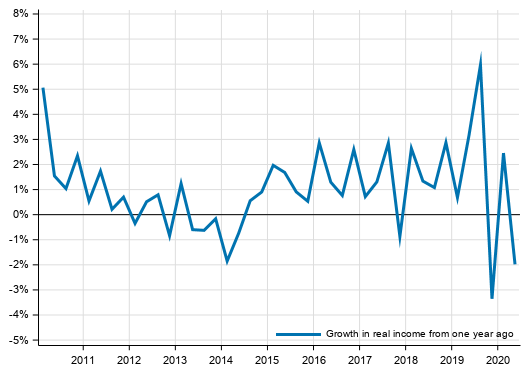Published: 18 September 2020
Households' saving rate growing in the second quarter
Households’ saving rate grew in April to June from the previous quarter. The saving rate grew because consumption expenditure decreased clearly more than disposable income. The investment rate of households grew slightly from the previous quarter. The profit share of the non-financial corporations sector rose even though value added contracted considerably. The lower compensation of employees paid and growth in received subsidies on production turned the profit share into growth. The investment rate of the non-financial corporations sector fell from the previous quarter. These data derive from Statistics Finland’s quarterly sector accounts.
Key indicators for households and non-financial corporations, seasonally adjusted

The key figures were calculated from seasonally adjusted time series. Sector accounts are calculated only at current prices. However, an indicator describing the development adjusted for price changes is calculated for households' adjusted disposable income. The profit share, saving rate and investment rate are calculated from net figures, from which consumption of capital is removed. Households do not include non-profit institutions serving households.
The exceptional situation caused by the coronavirus pandemic and the macroeconomic shock were visible in several sectors. Enterprises' value added and compensation of employees paid decreased. In the household sector, compensation of employees received in particular decreased the disposable income. However, households adjusted their consumption more strongly than the change in disposable income and the saving rate made a steep upturn. At the same time as the diminished tax revenue decreased general government revenue, general government supported the non-financial corporations sector exceptionally much. For this reason, general government deficit grew significantly. Dividend payments have also been postponed, which is visible throughout the economy as reduced property income and expenditure.
The data of quarterly sector accounts will become revised as source data are updated. Despite the coronavirus pandemic, the source data normally used in the compilation of the statistics were also now all available and no exceptional deficiencies related to the data were detected. Some seasonally adjusted figures contain more uncertainty than usual.
Households
In April to June, households' seasonally adjusted saving rate grew by nearly six percentage points to 9.7 per cent. The saving is derived by deducting consumption expenditure from disposable income. The saving is positive if households' disposable income is greater than households' consumption expenditure. The saving rate refers to the share of households’ savings in disposable income. In the second quarter of 2020, households' disposable income decreased, but consumption diminished clearly even more, which resulted in a significant increase in the saving rate.
Households' seasonally adjusted investment rate grew slightly from the previous quarter and stood at 14.5 per cent. The investment rate is the ratio of households' investments to disposable income. Most of households' investments were investments in dwellings. Households' investments remained in practice on level with the previous quarter but the investment rate rose clearly as disposable income diminished.
In the second quarter of 2020, households’ disposable income decreased at current prices by -1.7 per cent, that is, by about EUR half a billion from the corresponding quarter of the year before. The key components of disposable income on the income side are wages and salaries received, entrepreneurial and property income, and social benefits received. The biggest expense items are taxes paid and social contributions. Wages and salaries received in the second quarter of 2020 decreased by over EUR one billion and property income by EUR 0.7 billion, while social benefits received grew by nearly EUR one billion compared to the figures one year ago. On the expense side, both taxes paid and social contributions paid decreased, but less, in total close on EUR half a billion compared with the figures one year ag.o
When individual services produced by the public sector and non-profit institutions, such as educational, health and social services, are added to disposable income, the concept of adjusted disposable income can be attained. Adjusted disposable income is the indicator recommended by the OECD for evaluating the economic well-being of households. In the second quarter of 2020, households’ adjusted disposable income decreased at current prices by -1.7 per cent and adjusted for price changes by -2.0 per cent from the corresponding quarter of the year before. The indicator describing the development of adjusted disposable income adjusted for price changes can be found in Appendix table 3 of this publication.
Volume development of households’ adjusted disposable income

Compensation of employees paid by non-profit institutions serving households decreased by -8.3 per cent compared with the quarter of one year ago. In both sports and culture the activities of many associations were discontinued altogether in spring, which was also visible in wage payment.
In these statistics, the households sector only covers the actual households sector S14. Sector S15, non-profit institutions serving households, is calculated and published separately. In Eurostat’s publication, the households sector also includes the data for sector S15. Another difference to Eurostat's publication is in how consumption of fixed capital is taken into account. Eurostat publishes investment and saving rates as gross figures, i.e. including consumption of fixed capital. Net data are used in these statistics, that is, when consumption of fixed capital is taken into account, saving and investment rates decrease.
Profit share of non-financial corporations growing
In the second quarter of 2020, the seasonally adjusted profit share of non-financial corporations grew by 3.2 percentage points to 33.2 per cent. The profit share refers to the share of the operating surplus in value added. The profit share of non-financial corporations made a clear upturn because even though value added fell, compensation of employees paid also decreased and general government strongly supported non-financial corporations with subsidies on production. The investment rate of non-financial corporations, or the proportion of fixed capital investments in value added fell by 0.3 percentage points to 28.6 per cent. Thus, investments went down relatively more than value added.
The financial deficit calculated from figures unadjusted for seasonal variation diminished by EUR 1.3 billion from the corresponding quarter of the previous year and amounted to EUR 0.4 billion.
Profits of financial and insurance corporations fell
Seasonally adjusted value added in financial and insurance corporations fell by 1.7 per cent from the previous quarter. Output went down by 1.7 per cent and intermediate consumption by 1.9 per cent. In turn, compensation of employees in the sector grew by 1.7 per cent in the second quarter of the year. The operating surplus describing profits fell by 5.4 per cent from EUR 688 million in the previous quarter to EUR 651 million. Profits went down particularly in financial auxiliaries. Insurance corporations' profits, in turn, grew.
The property income and expenditure of financial and insurance corporations fell in the second quarter. In particular, dividends received and paid by the sector decreased as the ECB instructed banks to suspend the payment of dividends.
Value added and operating surplus describe the income that is generated from providing financial services to the public. They do not include property income or holding gains of securities.
Financial position of general government weakened from a year ago
Consolidated total general government revenue fell and consolidated total expenditure grew. The difference between revenue and expenditure, that is, the financial position of general government weakened by EUR 5.3 billion from the year before and was EUR 3.7 billion in deficit.
The statistics on quarterly sector accounts examine general government as a whole. More detailed information on quarterly sector accounts of general government can be found in the statistics on general government revenue and expenditure where the sub-sectors are specified: : http://www.stat.fi/til/jtume/index_en.html
International trade in goods and services plummeted in the second quarter of 2020
Exports of goods abroad from Finland amounted to EUR 13.8 billion in the second quarter of 2020. The decrease from the quarter one year back was EUR 2.0 billion (12.5 per cent). Exports of services amounted to EUR 5.7 billion, which was 27.7 per cent less than one year ago. Imports of goods to Finland amounted to EUR 12.8 billion. Compared to one year ago, the value of imports of goods decreased by EUR 3.2 billion (20.0 per cent). Imports of services amounted to EUR 6.4 billion, which was 21.8 per cent less than one year ago. The balance of goods and services showed a surplus of EUR 0.3 billion in the second quarter of 2020.
Property income paid abroad was around EUR 0.4 billion higher than property income received from abroad. Property income includes dividends, interests and reinvested earnings. Current transfers paid abroad from Finland were around EUR 0.8 billion higher than current transfers paid from abroad to Finland. The most significant current transfer item is the GNI payment paid by the state to the EU. The current account was EUR 0.8 billion in deficit in the second quarter of 2020.
Data and methods used
The quarterly data become revised as source data are updated. The biggest revisions take place for the last two to three years, because the data in the annual accounts are still preliminary. The data in the publication are based on the data sources available by 6 September 2020. The data for 1999 to 2019 mainly correspond with the annual sector accounts of the National Accounts.
The saving rate, profit share and investment rate in the quarterly publication of sector accounts are net amounts, i.e. consumption of fixed capital has been removed from the figures. In addition, financial accounts data on the stock of households’ loan debts are used in calculating households’ indebtedness rate. The indebtedness rate is presented adjusted and non-adjusted for seasonal variation in the database table of sector accounts. The indebtedness rate from figures non-adjusted for seasonal variation is published by financial accounts. The key indicators in these statistics were calculated as follows:
Households' saving rate = B8N / (B6N+D8R)
Households' investment rate = P51K / (B6N+D8R)
Households' indebtedness rate = F4 / B6N
Profit share of non-financial corporations = B2N / B1NPH
Investment rate of non-financial corporations = P51K / B1NPH
The indicator of households' adjusted disposable income is calculated using the price data of the statistics on quarterly national accounts, with which the components of adjusted disposable income are deflated. Households' disposable income is deflated with the implicit price index of household consumption expenditure. Price data are also available for the consumption of non-profit institutions serving households. As a methodological shortcoming, general government individual consumption expenditure has to be deflated with the total general government consumption expenditure for lack of more accurate data. The volume time series was formed with the annual overlap method.
Source: Sector accounts, Statistics Finland
Inquiries: Jarkko Kaunisto 029 551 3551, Katri Soinne 029 551 2778, kansantalous.suhdanteet@stat.fi
Head of Department in charge: Mari Ylä-Jarkko
Publication in pdf-format (453.5 kB)
- Tables
-
Tables in databases
Pick the data you need into tables, view the data as graphs, or download the data for your use.
Appendix tables
- Figures
- Revisions in these statistics
-
- Revisions in these statistics (18.9.2020)
Updated 18.9.2020
Official Statistics of Finland (OSF):
Quarterly sector accounts [e-publication].
ISSN=2243-4992. 2nd quarter 2020. Helsinki: Statistics Finland [referred: 20.4.2025].
Access method: http://stat.fi/til/sekn/2020/02/sekn_2020_02_2020-09-18_tie_001_en.html

